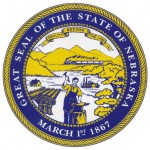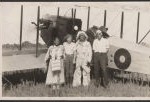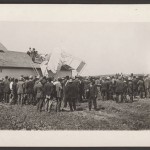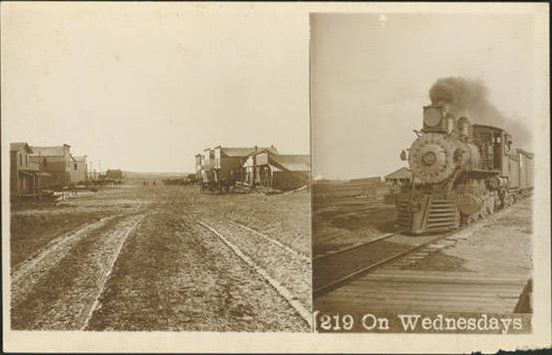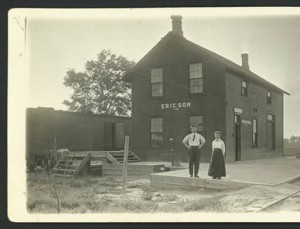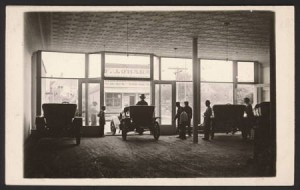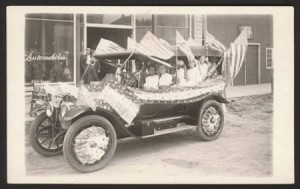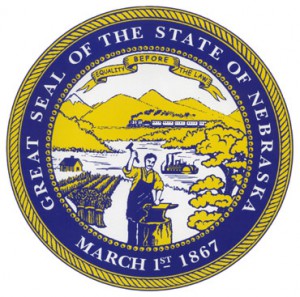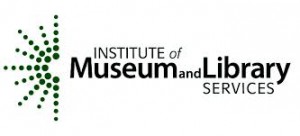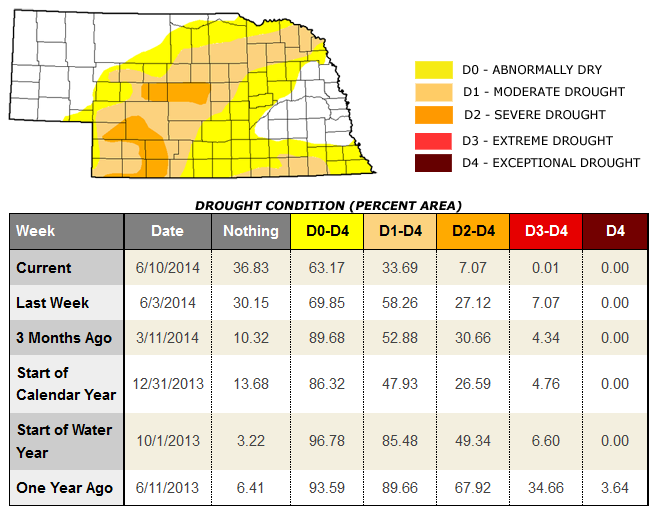Search the Blog
Categories
- Books & Reading
- Broadband Buzz
- Census
- Education & Training
- General
- Grants
- Information Resources
- Library Management
- Nebraska Center for the Book
- Nebraska Memories
- Now hiring @ your library
- Preservation
- Pretty Sweet Tech
- Programming
- Public Library Boards of Trustees
- Public Relations
- Talking Book & Braille Service (TBBS)
- Technology
- Uncategorized
- What's Up Doc / Govdocs
- Youth Services
Archives
Subscribe
Author Archives: Mary Sauers
Open Enrollment for 2015 Health Insurance coverage begins November 15th
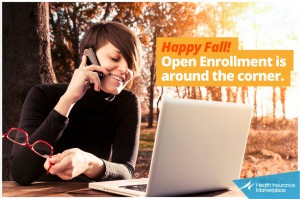 A one-page guide to the Health Insurance Marketplace
A one-page guide to the Health Insurance Marketplace
Here’s a quick rundown on the most important things to know about the Health Insurance Marketplace, sometimes known as the health insurance “exchange.” Follow the links for more information on each topic.
Important. 2014 Marketplace Open Enrollment ended March 31. You can still buy a Marketplace health plan only if you qualify for a special enrollment period. You can apply for Medicaid and CHIP any time. Find out if you qualify for a Special Enrollment Period or Medicaid and CHIP. Open Enrollment for 2015 coverage starts November 15, 2014.
The Health Insurance Marketplace helps uninsured people find health coverage. Fill out a Marketplace application and we’ll tell you if you qualify for:
- Private health insurance. Plans cover essential health benefits, pre-existing conditions, and preventive care. Some plans include dental coverage. In other cases, free-standing dental plans are available.
- Lower costs based on your household size and income. You can preview plans available in your area right now, with prices based on your income and household size. Most people who apply will qualify for lower costs.
- Medicaid and the Children’s Health Insurance Program (CHIP). These programs cover millions of families with limited income. If it looks like you qualify, we’ll share information with your state agency and they’ll contact you. Many but not all states are expanding Medicaid to cover more people. Find out what Medicaid expansion means for you.
Most people are eligible to use the Marketplace. Learn more about immigration status and eligibility.
Most people must have health coverage or pay a penalty. If you don’t have coverage in 2014, you’ll pay a fee of either 1% of your income, or $95 per adult ($47.50 per child), whichever is higher. You’ll pay the fee on your 2015 income taxes.
Some people qualify for an exemption from the fee, based on income or other factors.
You’re considered covered if you have Medicare, Medicaid, CHIP, any job-based plan, any plan you bought yourself, COBRA, retiree coverage, TRICARE, VA health coverage, or some other kinds of health coverage.
You can also buy a plan outside the Marketplace and still be considered covered. If you buy outside the Marketplace, you won’t be eligible for premium tax credits or lower out-of-pocket costs based on your income.
If you’re eligible for job-based insurance, you can consider switching to a Marketplace plan. But you won’t qualify for lower costs based on your income unless the job-based insurance isn’t considered affordable or doesn’t meet minimum requirements.
If you have Medicare, you’re considered covered and don’t have to make any changes. If you have Medicare, you can’t use the Marketplace to buy a supplemental plan or dental plan.
Learn how to apply through the Marketplace—online, by phone, or with a paper application..
Questions? Call 24 hours a day, 7 days a week: 1-800-318-2596 (TTY: 1-855-889-4325)
Webinar: Grant Writing for Preservation and Access Digitization Projects
A live training webinar, “Grant Writing for Preservation and Access Digitization Projects,” will be presented on September 30, 2014.
This webinar has been rescheduled. Registration is open to any new registrants. Those who have already registered do not have to re-register. Your previous registration will carry over to the new date.
Register today for “Grant Writing for Preservation and Access Digitization Projects”
- Start time: 2 p.m. Eastern Time
- Duration: 60 minutes
- Speaker: David Walls, Preservation Librarian, U.S. Government Printing Office
- Learning outcomes: The webinar will cover: preparing for your grant proposal, matching your project to the appropriate funding agency, writing an effective grant proposal while avoiding common faults, and understanding the review process.
- Expected level of knowledge for participants: No prerequisite knowledge required.
The webinar is free, however registration is required. Upon registering, a confirmation email will be sent to you. This registration confirmation email includes the instructions for joining the webinar.
Registration confirmations will be sent from sqldba @ icohere.com. To ensure delivery of registration confirmations, registrants should configure junk mail or spam filter(s) to permit messages from that email address. If you do not receive the confirmation, please notify GPO at FDLPOutreach.
GPO’s eLearning platform is now presenting webinars using WebEx. In order to attend or present at a GPO-hosted webinar, a WebEx plug-in must be installed in your internet browser(s). Download instructions.
For access to other archived Federal Depository Library Program webinars and webcasts and for a calendar of upcoming webinars and educational events, please visit the Training and Events page on FDLP.gov.
Brown Bag History Forum: Nebraska Orphan Train Riders
Webinar: How Social Media Can Help Your Business Succeed
Looking for Social Media Tips? Register for the SBA and Hootsuite Webinar
Social media is becoming an increasingly important communication channel for small businesses. However, knowing where to start is perhaps the number one obstacle holding many small business owners back. That’s why SBA has teamed up with Hootsuite for a free webinar about how social media can help your small business succeed on Tuesday, September 16 at 2:00 PM ET (1:00 PM CENTRAL).
In this 1 hour webinar, Don Baron, Director of SMB Business Development at Hootsuite will share strategies that can help you better utilize social media for your small business.
Participants will learn:
- Why social media is relevant for small businesses
- A variety of social media strategies as they relate to marketing, sales and support
- Tactics and tools that will help you execute your strategies
- Case studies of small business success on social media
Small Business Administration Opportunity for Auburn and Nemaha County in Nebraska
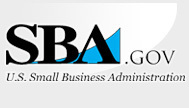 Small businesses in certain parts of southeast Nebraska seeking to buy and sell to the federal government soon will be able to take advantage of a program to successfully bid for contracts.
Small businesses in certain parts of southeast Nebraska seeking to buy and sell to the federal government soon will be able to take advantage of a program to successfully bid for contracts.
Thanks to a redesignation Oct. 1, Auburn and Nemaha County will be qualified as a Historically Underutilized Business Zones (HUBZone). This program helps small businesses in urban and rural communities gain preferential access to federal procurement opportunities. SBA’s HUBZone program is in line with the efforts of both the Administration and Congress to promote economic development and employment growth in distressed areas by providing access to more federal contracting opportunities.
The program’s benefits for HUBZone-certified companies include competitive bidding for contracts, a 10 percent price evaluation preference in full and open contract competitions, as well as subcontracting opportunities. Moreover, the federal government has a goal of awarding three percent of all dollars for federal prime contracts to HUBZone-certified small business concerns.
The SBA regulates and implements the HUBZone program by determining which businesses are eligible to receive HUBZone contracts, maintains a listing of qualified HUBZone small businesses that federal agencies can use to locate vendors, adjudicates protests of eligibility to receive HUBZone contracts and reports to the Congress on the program’s impact on employment and investment in HUBZone areas.
Auburn and Nemaha County were redesignated based on the high rate of unemployment in that area.
For guidance in southeast Nebraska on bidding for federal contracts, please contact Julie Ann Wilhelm at the Auburn Procurement Technical Assistance Center at 402-414-5077 or jwilhelm@unomaha.edu.
Updates to HUBZones are public and anyone can subscribe to them. Consider subscribing to HUBZone News.
As always, small businesses and economic resource providers can contact the SBA helpdesk at hubzone@sba.gov with your questions. You may also call in to the office hours. Details are on our website at www.sba.gov/hubzone.
Webinar: Understanding Social Security and MySSA
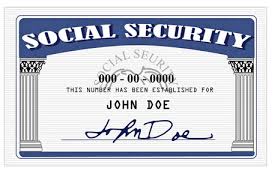 The American Library Association (ALA) is encouraging librarians to know how to use My Social Security (MySSA), the online Social Security resource.
The American Library Association (ALA) is encouraging librarians to know how to use My Social Security (MySSA), the online Social Security resource.
A webinar, presented by leaders and members of the development team of MySSA, will provide listeners with an overview of MySSA. In addition to receiving benefits information in print, the Social Security Administration is encouraging librarians and patrons to create an online MySSA account to view and track benefits.
Listeners will learn about viewing earnings records and receiving instant estimates of their future Social Security benefits. Those already receiving benefits can check benefit and payment information and manage their benefits.
Speakers include:
- Maria Artista-Cuchna, Acting Associate Commissioner, External Affairs
- Kia Anderson, Supervisory Social Insurance Specialist
- Arnoldo Moore, Social Insurance Specialist
- Alfredo Padilia Jr., Social Insurance Specialist
- Diandra Taylor, Management Analyst
Registration is full for the live webinar on Wednesday, September 17, 2014.
However, to be notified when the recorded session is available, please go to Lib2Gov Webinar: MySSA.
.
FREE WEBINAR: Federal Legislative History 101
 A live training webinar, “Federal Legislative History 101,” will be offered on Tuesday, October 7, 2014.
A live training webinar, “Federal Legislative History 101,” will be offered on Tuesday, October 7, 2014.
Register today for “Federal Legislative History 101”
- Start time: 2:00 p.m. Eastern Time/ 1:00 Central
- Duration: 60 minutes
- Speaker: Rick McKinney is Assistant Law Librarian / Legislative Librarian at the Federal Reserve Board Law Library in Washington, D.C., where he has served for the past 30 years. He is the founder and principal editor of LLSDC’s Legislative Source Book on the Internet and has authored numerous articles and presentations in the field of Federal statutory, legislative, and regulatory research.
- Learning outcomes: The webinar will discuss the ways in which Federal statutes are published and cited, what Federal legislative histories are and how they are used, the normal steps in compiling and researching Federal legislative histories, and the various resources available for Federal legislative history research – both free and commercial.
- Expected level of knowledge for participants: No prerequisite knowledge required
The webinar is free, but registration is required. Upon registering, a confirmation email, which includes instructions for joining the webinar, will be sent to you.
Registration confirmations will be sent from sqldba @ icohere.com. To ensure delivery of registration confirmations, registrants should configure junk mail or spam filter(s) to permit messages from that email address. If you do not receive the confirmation, please notify GPO at FDLPOutreach.
GPO’s eLearning platform is now presenting webinars using WebEx. In order to attend or present at a GPO-hosted webinar, a WebEx plug-in must be installed in your internet browser(s). Download instructions.
For access to other archived Federal Depository Library Program webinars and webcasts and for a calendar of upcoming webinars and educational events, please visit the Training and Events page on FDLP.gov.
New Government Publications Received at the Library Commission
Planes, Trains, and Automobiles
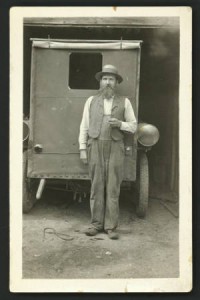 One of the fun things I like to do while browsing through Nebraska Memories is to find pictures that remind me of a phrase or movie title, then add a Nebraska twist. That led me to today’s post about Nebraska photographer John Nelson, and the movie “Planes, Trains, and Automobiles.”
One of the fun things I like to do while browsing through Nebraska Memories is to find pictures that remind me of a phrase or movie title, then add a Nebraska twist. That led me to today’s post about Nebraska photographer John Nelson, and the movie “Planes, Trains, and Automobiles.”
John Nelson was born in Halestad, Sweden in 1864. He came to Nebraska with his parents at the age of seventeen. His many photographs tell the story of small town life in Nebraska during the first decades of the 20th century. His subjects included people, towns, businesses, community activities, early airplanes, trains, and automobiles.
The picture to the left is of the photographer himself, standing in front of the rear end of his motorized portable darkroom, between 1907 and 1917.
The pictures immediately below are the first stop in the planes, trains, and automobiles tour. They are of a biplane with its’ pilot, two Native Americans and a woman, and then a crowd of onlookers at the site of an airplane crash, respectively, about the same time period. These are just two of several airplane photographs taken by John Nelson found in Nebraska Memories, and illustrate the variety of pictures he took.
Trains are our next stop in the planes, trains and automobiles tour. Mr. Nelson took photographs of the trains themselves, but also took photographs of the people and places associated with the railroads. This can be seen in the pictures below of the “219 on Wednesdays” coming into a small Nebraska town, and in the picture of a couple standing outside the Ericson, Nebraska train depot.
Then last on the tour, but certainly not least, are the pictures of automobiles. John Nelson took many pictures of cars: everything from cars in downtown Omaha to individuals in or beside their cars, and from the F.J. O’Hara Buick Dealership in Spalding, Nebraska to automobiles decorated for parades, as seen below.
I hope you’ve enjoyed our photographic tour of John Nelson’s planes, trains, and automobiles. Visit Nebraska Memories to search for or browse through many more historical images digitized from photographs, negatives, postcards, maps, lantern slides, books and other materials.
Nebraska Memories is a cooperative project to digitize Nebraska-related historical and cultural heritage materials and make them available to researchers of all ages via the Internet. Nebraska Memories is brought to you by the Nebraska Library Commission. If your institution is interested in participating in Nebraska Memories, see http://nlc.nebraska.gov/nebraskamemories/participation.aspx for more information, or contact Beth Goble, Historical Projects Librarian, or Devra Dragos, Technology & Access Services Director.
Posted in Nebraska Memories
Leave a comment
This day in history…
Today marks the 100th anniversary of the opening of the Panama Canal. Below is a poster sent out by the U.S. Census Bureau to commemorate this remarkable feat of engineering.
Doc Spot: New Website “Executive Orders and Other Presidential Documents: Sources and Explanations”
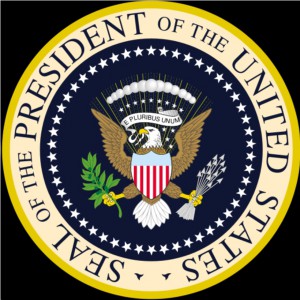 The Legislative Research Special Interest Section of the Law Librarians Society of Washington, D.C., Inc. (LLSDC) is pleased to announce the availability of a new website entitled “Executive Orders and Other Presidential Documents: Sources and Explanations.” The site attempts to briefly lay out and link to all major sources for these materials which includes Presidential directives, proclamations, signing statements, executive orders, memoranda, and other documents. In addition the site links to many sources, such as CRS reports, that explain these documents.
The Legislative Research Special Interest Section of the Law Librarians Society of Washington, D.C., Inc. (LLSDC) is pleased to announce the availability of a new website entitled “Executive Orders and Other Presidential Documents: Sources and Explanations.” The site attempts to briefly lay out and link to all major sources for these materials which includes Presidential directives, proclamations, signing statements, executive orders, memoranda, and other documents. In addition the site links to many sources, such as CRS reports, that explain these documents.
While the sections listed on the new website are available online, the Nebraska Library Commission does also have three of the titles in print format: The Code of Federal Regulations – Title 3 – Presidential Documents ; the Federal Register ; and Public Papers of the President. These titles, and thousands of other state and federal publications, are available either in print or online through the Nebraska Publications Clearinghouse. Feel free to browse the catalogs, or give us a call and we’ll be happy to help you find what you’re looking for.
New Government Publications Received at the Library Commission
Congress Passes Legislation Recognizing Libraries in Workforce Development
Congress recently took a giant leap forward to improve the delivery of job training and workforce development by passing the Workforce Innovation and Opportunity Act of 2014 (WIOA). Overwhelmingly approved by both the House and the Senate and supported by the President, the legislation is the result of a bipartisan agreement that recognizes the vital role our government plays in providing the services and resources job seekers need to access the kinds of skills training, career information, and education that are required for today’s job market.
The bill includes several exciting changes that update past workforce development laws and better coordinate federal resources by modernizing job training and identifying strategic workforce investments. IMLS has long recognized and supported the services libraries provide to help the American workforce rebound. And it is especially gratifying to see lawmakers from both sides of the aisle acknowledge the essential connection of public libraries to communities as career improvement partners in WIOA.
For public libraries, the new bill identifies them as eligible for funds as One-Stop partners with the ability to provide an expansive array of job search services. Also, it recognizes libraries as important providers of federally supported training and employment services for adult education and literacy. The legislation instructs State and Local Workforce Development Boards to boost “digital literacy skills” at training centers—the very definition of “digital literacy” originates from the law that created IMLS and is referenced in WIOA!
We are delighted that the public library’s role in improving our workforce development system has been acknowledged. IMLS will continue to support this work with public and private partnerships and grants. As an example, we recently partnered with the U.S. Department of Education’s Office of Career, Technical and Adult Education (OCTAE) to assist the estimated 3 million Americans who are seeking access to federal job information, education, and training by connecting them through resources at their public libraries. We are also partnering with the U.S. Department of Labor Employment and Training Administration (ETA) to highlight effective practices and encourage additional collaboration between the workforce investment system and public libraries.
Every day, people in communities across the U.S. are using libraries to access the Web for career development—participating in GED institutes, improving their English literacy and digital literacy, and finding work.
We applaud Congress, especially longtime library supporters Sen. Jack Reed (R.I.) and Rep. Rush Holt (NJ), on passing the Workforce Innovation and Opportunity Act of 2014 and for President Obama’s continued leadership in assisting American workers and employers. We also thank them for what it will do to serve our nation’s job seekers and help libraries be better equipped to contribute to the country’s economic vitality.
**By Susan H. Hildreth, Director, IMLS. Reprinted from UpNext: The Official Blog of the Institute of Museum and Library Services, July 16th, 2014.
Doc Spot: Lincoln and His Printers : GPO in the Civil War
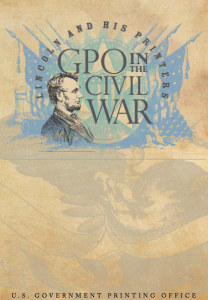 The U.S. Government Printing Office (GPO) first began operations on March 4, 1861, the same day as President Abraham Lincoln’s inauguration. The GPO set up shop in a printing plant originally built by Cornelius Wendell, a longtime contract printer for Congress. Located at the corner of North Capitol and H Streets NW, the facility was the largest printing plant in Washington and one of the largest in the U.S. at that time.
The U.S. Government Printing Office (GPO) first began operations on March 4, 1861, the same day as President Abraham Lincoln’s inauguration. The GPO set up shop in a printing plant originally built by Cornelius Wendell, a longtime contract printer for Congress. Located at the corner of North Capitol and H Streets NW, the facility was the largest printing plant in Washington and one of the largest in the U.S. at that time.
The first head of the GPO was John D. Defrees, an Illinois newspaper publisher, politician, and friend of President Lincoln. With the outbreak of the Civil War, the GPO grew rapidly to keep pace with military and civilian printing needs. In 1864, GPO employees participated more directly in the war when Company F of the Interior Department Regiment, comprised of GPO printers and pressmen, marched into Northwest Washington to help repel Confederate forces under General Jubal Early.
Lincoln and His Printers : GPO in the Civil War is a brochure published by the GPO to accompany an exhibit of the same name. It is a short history of the GPO during the Civil War years, and includes pictures of some of the people, buildings, and documents (including the Emancipation Proclamation) that were most important during the early years of the GPO. Click on the title above to view the full-text online, or visit the Nebraska Library Commission to find this and many other state and federal documents.
Small Business Administration at work in Nebraska…
 Nebraska beef plant reopens, creates jobs thanks to SBA International Trade Loan financing
Nebraska beef plant reopens, creates jobs thanks to SBA International Trade Loan financing
For five years, the meatpacking plant in this part of ranch country in northwest Nebraska stood vacant and silent. Now, thanks in part to new owners and SBA financing, the plant has re-opened as a supplier for organic, natural grass-fed, premium and halal beef for domestic and overseas markets, and given a small town a big economic jolt.
Open Range Beef purchased the shuttered plant from the city of Gordon in late June 2013, and have spent the last few months upgrading the operation with state-of-the-art equipment and material. With the purchase and re-opening, the business also created 100 new jobs, said co-owner Pat Shudak (pictured, left), a big deal for a town of around 1,800 people.
The company was approved for $3.8 million in financing in April using the SBA’s International Trade Loan program, one of only four guaranteed loans of this type in the four-state region this fiscal year. 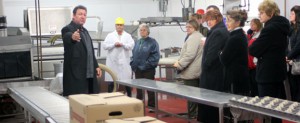
The 36,000-square foot plant expects to hit a target of 250-300 head of cattle per day, or about $120 million worth of cattle per year, from local ranchers for its USDA-certified beef processing operation. Open Range Beef chiefly will serve Rastelli Foods, a New Jersey-based humane and sustainable agricultural company with high-end clients in both domestic and overseas markets.
Serving as a hub for specialty and organic meats for export, the company had to buy more expensive equipment such as hot water to clean carcasses, and follow strict guidelines. For example: there’s a long list of specific requirements for meat to be certified halal if it’s to be exported to Muslim customers.
“We’ll be sending beef to Japan, Hong Kong, the Middle East, Europe,” Shudak added. “The qualifications and restrictions are long; some dictate cattle only be 30 months or younger, and some countries don’t allow importing certain parts, such as livers, kidneys and parts outside the main cuts of meat. Each country’s certification is different.”
Because the plant is mid-sized, explained co-owner Jill Noetzelman, “we can switch gears whenever we need to for custom slaughtering, which benefits meat producers and the packer,” a competitive advantage over bigger plants, such as those which process up to 5,000 head of cattle a day. Those enormous operations leverage economies of scale with relatively inflexible work flows can’t allow for smaller, specialty orders.
As a result, Shudak claimed, Open Range Beef’s operation expects to have a direct positive impact of nearly $5 million a year and an overall economic impact of $22 to 25 million a year for the area.
“We also purchase our supplies as much as possible locally from retail, lumber yards and hardware stores,” Noetzelman said, a move which generates significant secondary economic benefits for the town from the plant’s presence.
“It’s too soon to say what our revenues look like,” Shudak added. But the outlook is bright: “The cattle market was at an all-time high when we took over, and it’s even looking a lot better now.”
Ranchers also will benefit with Open Range Beef’s location: the next closest packing plants for livestock producers in the area are Lexington and Hastings, Neb., and Fort Morgan, Colo., some hundreds of miles away.
Shudak said the ownership team moved from building a solar development company in Hawaii as part of its investment portfolio to the specialty beef industry after a high school friend of Shudak’s mentioned he had considered going into the fast-growing specialty beef business. Private equity supplied the financing to purchase the plant, but the team needed more for the equipment, operating capital and cattle purchases.
“This wasn’t a conventional loan like for a retail or storefront business,” Noetzelman said. So they turned to BizCapital, a multi-state lender which offers competitive loans to small- and medium-sized companies located in underserved markets, and one of Missouri’s Lenders of the Year for 2012, and First Bank of the Lake, an Ozarks-based lender experienced with SBA applications. With their help over the six-month application process, Open Range Beef was approved for $3.8 million in financing in April 2014 using the SBA’s International Trade Loan program, one of only four guaranteed loans of this type in the four-state region this fiscal year. This program which offers a 90 percent guarantee to the lender, offers access to capital for a small business in a position to expand existing export markets or develop new export markets.
“I don’t believe we would have put this together without the SBA,” Shudak said. “The nice thing is that we had a lot of equity in this plant and had real strong appraisals. In approving our loan, the SBA focused on job creation, helping the local economy, exporting, things that really matter to our business. Without the SBA, we found banks weren’t keen on certain businesses, and packing houses were one of them.”
And for a good reason: the business of beef harvesting and processing industry is cash-intensive and a volatile commodity-based one.
Shudak said future plans call for expansion of the plant’s cooler space and adding more jobs as the company’s capacity grows.
“The majority of our employees we have now we first hired at the beginning for construction work during the renovation,” Shudak said. “When we started the remodeling there was a real lack of available construction crews in the area, so we brought in a construction manager and hired former plant workers and trained them.”
When they finished the construction work, those same employees put down their hammers and put on their frocks, and Shudak noticed “there’s a huge amount of pride in the building, because they did the work to bring it back.”
While the town’s residents, along with members from the nearby Oglala Sioux Tribe reservation, who filled many plant positions in the past, make for a healthy labor pool, the plant’s promised growth is enough so a challenge for Gordon’s city manager is to address potential housing shortages incoming workers likely are to face.
Open Range Beef also points to the area’s diverse work force as a benefit, with Native American, African-American, and Guatemalan and other Hispanic employees of all working ages on staff, and young professionals in the area also seeking to be part of the business.
“You know, our philosophy coming into the business here is that you treat your employees like family, appreciate each individual, and create the positive work environment where employees who spent 8-10 hours a day here want to come to work here,” Noetzelman said.
Reprinted from SBA.gov. For more information about the U.S. Small Business Administration. and how it’s loans and grants can help, visit SBA.gov/Loans & Grants.
Nebraska Sesquicentennial Commission
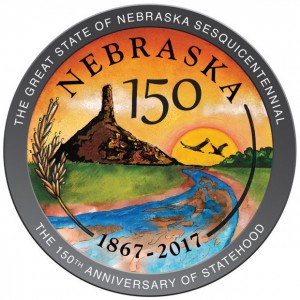 One of the new Nebraska laws going into effect today, July 1st, 2014, will create a state Sesquicentennial Commission to plan for Nebraska’s 150th anniversary as a state in 2017. The Nebraska Sesquicentennial Commission will consist of 17 members appointed by the governor. Starting today, Gov. Dave Heineman will have 60 days to appoint the members.
One of the new Nebraska laws going into effect today, July 1st, 2014, will create a state Sesquicentennial Commission to plan for Nebraska’s 150th anniversary as a state in 2017. The Nebraska Sesquicentennial Commission will consist of 17 members appointed by the governor. Starting today, Gov. Dave Heineman will have 60 days to appoint the members.
The Sesquicentennial seal, at left, blends the Platte River with Chimney Rock and sandhill cranes. It will be used for all official events and documents relating to Nebraska’s celebration of 150 years of statehood. Information about early planning and fundraising efforts is available online at Nebraska150.org
Doc Spot: Drought Monitor Map
Good news! Drought continues to lessen across Nebraska, according to the latest Drought Monitor Map for the week ending June 22, 2014:
This map is just one of the many resources provided by the National Drought Mitigation Center, which is housed at the University of Nebraska-Lincoln. Visit the website for news, state and national maps, monitoring tools, information for kids, and resources for teachers.
Going Postal…
In the more than two hundred years since Benjamin Franklin was appointed our first Postmaster General in 1775, the Postal Service™ has grown and changed with America. Not only have there been changes in moving the mail (ranging from the basic horse and rider Pony Express, to stagecoaches, trains, boats, airplanes, and even dog sled), but there have also been changes in post office buildings. The types of buildings used, and the architecture of Nebraska post offices through the years can easily be seen in the many photographs and postcards found in Nebraska Memories.
 This first picture, taken by Nebraska photographer John Nelson, shows an early 1900’s Nebraska town with a dirt street lined with buildings. One of the stores has a sign on it that says, “Brown’s” which was also the post office.
This first picture, taken by Nebraska photographer John Nelson, shows an early 1900’s Nebraska town with a dirt street lined with buildings. One of the stores has a sign on it that says, “Brown’s” which was also the post office.
It was not uncommon for a general store to serve as the town post office as well. The building in this picture, with its’ plain front and wooden sidewalk, was not many years removed from and not much changed from frontier days style buildings.
Many buildings and businesses did double and even triple duty, like this undertaker, furniture and post office storefront in Papillion, Nebraska, circa 1907. 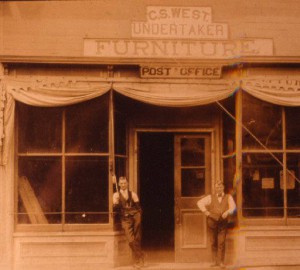
The building was located on the west side of Washington Street between First and Second Streets, but had a little more “modern” store front with big plate glass windows. Charles West (probably the man on the right) served as the Postmaster of Papillion from 1901 to 1914. The man on the left is an unidentified clerk.
This next photograph shows another style of wooden building with a sign identifying it as the Loomis post office. A long wooden porch covered by an awning runs the length of the building. The postmaster, Gust F. Carlson, stands on the porch, leaning against one of the awning’s support poles. Three other men stand with him, including Axel Veegert (second from right), a mail carrier. A car is parked on the dirt road in front of the building, with a container labeled “U.S. Mail” attached to its side. 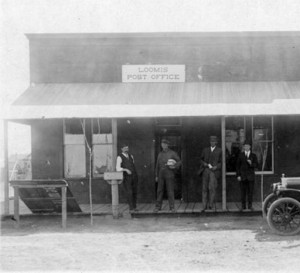
Wooden buildings gradually gave way to larger and more grand buildings, as evidenced by these photographs from Fremont, David City, and Omaha, respectively.
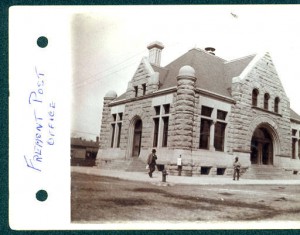 This Fremont post office building was on the northwest corner of Sixth and Broad Streets, built in 1893 in the more ornate Richardsonian Romanesque style. This style included the hipped roof with parapeted gable dormers, windows with rounded tops, deep-set windows with transoms, arched entries, and the contrasting smooth and rough wall textures.
This Fremont post office building was on the northwest corner of Sixth and Broad Streets, built in 1893 in the more ornate Richardsonian Romanesque style. This style included the hipped roof with parapeted gable dormers, windows with rounded tops, deep-set windows with transoms, arched entries, and the contrasting smooth and rough wall textures.
The David City post office was a one-story red brick building with wide steps leading to white double entry doors with arched contrasting brick-work above, arched windows with matching trim at each side of the door and smaller double-hung windows on the front and sides of the building, bushes around the foundation and lawn on two sides of the corner lot, a street light in front, sidewalks on two sides with brick streets in front. 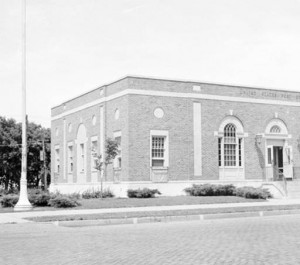
The postcard below, circa 1914, of the South Omaha branch of the post office, was located at 502 North 24th Street in South Omaha, Nebraska. The building was red brick, two stories tall, with arched windows and doors on the first floor and six columns on the front. 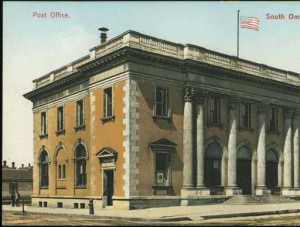
The layout of the interiors of buildings that were used as post offices are of interest as well, as seen in the following pictures.
The post Office in Spalding, Nebraska had a long cabinet with many pigeon-holes stuffed with letters, and the postmaster’s desk in front; 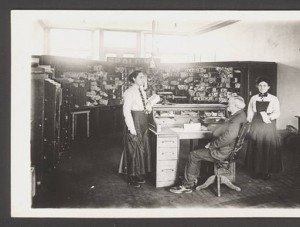
while another Post Office photograph shows a “Reading Room” where people could sit down at a desk to read their letters. 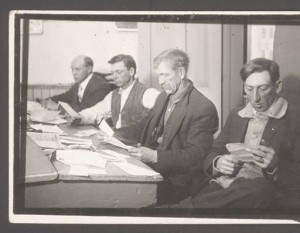
There is also this photograph of what the post office boxes at the back of the Potter, Nebraska general store looked like: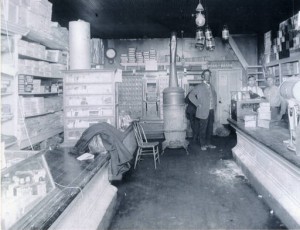
Thanks for joining me today as we journeyed back to look at Nebraska post office buildings from the past 100+ years. I hope you enjoyed it as much as I did!
Visit Nebraska Memories to search for or browse through many more historical images digitized from photographs, negatives, postcards, maps, lantern slides, books and other materials.
Nebraska Memories is a cooperative project to digitize Nebraska-related historical and cultural heritage materials and make them available to researchers of all ages via the Internet. Nebraska Memories is brought to you by the Nebraska Library Commission. If your institution is interested in participating in Nebraska Memories, see http://nlc.nebraska.gov/nebraskamemories/participation.aspx for more information, or contact Beth Goble, Historical Projects Librarian, or Devra Dragos, Technology & Access Services Director.
Posted in Nebraska Memories
Leave a comment
Registration now open for 25th Annual Nebraska Data Users Conference
 Registration is now open for the 25th Annual Nebraska Data Users Conference, August 19, 8:00 a.m. – 4:30 p.m.
Registration is now open for the 25th Annual Nebraska Data Users Conference, August 19, 8:00 a.m. – 4:30 p.m.
Attend in-person in Omaha or via webcast to learn about the latest data products, methods of access, and applications.
This year’s program includes:
- A special focus on aging and vital statistics.
- Release of the initial results from the 2014 Nebraska Metro and Rural Polls.
- Expanded hands-on computer trainings on American FactFinder, data websites/tools, and data mapping.
- Facilitated lunchtime discussions, back by popular demand.
Attend the conference to learn about:
- Census data basics.
- Powerful online data tools.
- The latest population trends.
- Poverty and the new poverty measure.
- Migration data and brain drain/gain.
- Library resources and STEM.
- Using data to apply for grants or to reach your audience.
Register early for full session options. The hands-on computer trainings have 30-person limits and will fill up fast.
Visit the website or view the attached flier for more details. Register at http://www.unomaha.edu/cpar/register.php.
2014 – 2015 Navigator Funding Announcement
![]() The Centers for Medicare and Medicaid Services (CMS) has announced a recent funding opportunity intended to support Navigators providing health insurance enrollment assistance in Federally-Facilitated and State Partnership Marketplaces in 2014 – 2015. You may learn more about this opportunity here: http://www.grants.gov/web/grants/search-grants.html?keywords=93.332.
The Centers for Medicare and Medicaid Services (CMS) has announced a recent funding opportunity intended to support Navigators providing health insurance enrollment assistance in Federally-Facilitated and State Partnership Marketplaces in 2014 – 2015. You may learn more about this opportunity here: http://www.grants.gov/web/grants/search-grants.html?keywords=93.332.
Many libraries have actively partnered with Navigator organizations in their communities to support outreach, education, and enrollment in the health insurance Marketplace established as part of the Affordable Care Act. Libraries have contributed in many ways, such as providing space for Navigator information sessions, making library computers available for enrollment sessions, and sharing resources from Navigators in person and online. HealthCare.gov defines Navigators as: An individual or organization that’s trained and able to help consumers, small businesses, and their employees as they look for health coverage options through the Marketplace, including completing eligibility and enrollment forms. These individuals and organizations are required to be unbiased. Their services are free to consumers.
You can learn more about Navigators and engaging other community health partners in the Partner Engagement section of WebJunction’s Health Happens in Libraries project site.



